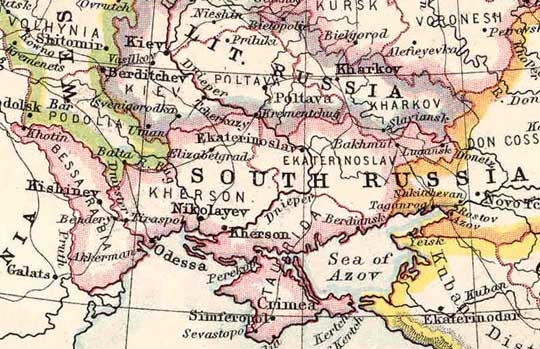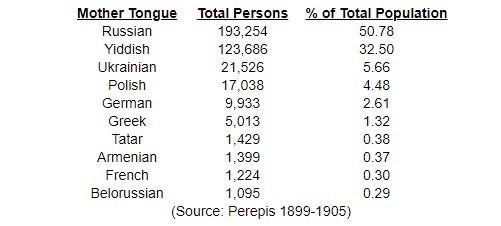According to various census reports and children’s birth certificates, Esther Stern came from Odessa.
While she was growing up there, her future husband, Morris, was raised in Bessarabia.
What was Odessa like when Esther grew up there?

Odessa is an administrative region (oblast in Russian), and the city of Odessa is in this region. Most ancestors likely came from a village within the oblast. Since the village names would be unfamiliar to immigration officials in the US and Canada, people would just say they came from the city itself.
Odessa was established in 1794 on land conquered from the Turks on the Black Sea where the fortress town of Khadzhibei was built.
In 1770 there was one Jewish headstone in the cemetery but by 1794 there were several Jewish institutions (a burial society, a Talmud Torah a hekdesh (hospice for the poor) and a kehilah (a Jewish structure).
Odessa was considered the most Western city in terms of culture and attitude and was the birthplace of Zionism. It was agreed that synagogue reform was necessary. Grain export was a major industry among Jews.
By 1851 the Jewish population grew to 17,000.
From the beginning, Jews were elected to municipal offices, unusual in Russia at that time.
Some 2,500 students had graduated from Odessa’s modern Jewish school by 1852
In the 1860s, Odessa became the empire’s center for Jewish periodical publication.
By 1875, more than 60 percent of the city’s commercial firms were in Jewish hands. By the early 20th Century, 89 percent of the grain export from Odessa was controlled by Jewish-owned firms, with Jews owning half of the city’s factories and 888 of its 1,410 smaller workshops.
Odessa was a “musical” place. Local cabarets performed Yiddish plays. Odessa’s and the theater were respected institutions. Violin lessons were sought after for Jewish children, and renowned cantors all from Odessa were some of the most famous in all of Russia.
Odessa was considered a melting pot and the 1897 census showed the 10 largest population groups.

This all sounds good, except that there were battles between the Jews and often the Greeks that occurred in 1821, 1859, and 1871. The last one was a precursor to the Pogrom of 1881. In the beginning the battles were mainly about modernization more than anti-Semitism, but by the later battles, there were definite anti-Semitic overtones. Tensions often escalated around Easter with Jewish and non-Jewish youths fighting each other. Jews were blamed for low wages, an economic downturn, and their political views, such as not supporting the war with Japan.
About one-third of the city’s Jews at the turn of the 20th century were on Passover relief. In 1881, Jews made up over 1/3 of the city’s population but less than 1/8 owned their own home. The Jewish poor mainly lived in the Moldavanka district near the port.
Here are some interesting statistics about the Jews in Odessa at the turn of the century:
- Some 26,000 store clerks, including women, worked in Odessa—many of them Jews and nearly all poorly paid.
- Jews were prominently represented among the city’s underworld.
- As of 1908, 30 of the 36 licensed brothels in Kherson province—most of them in Odessa—were owned by Jews.
Sadly, only one Jewish Cemetery, The Third Jewish Cemetery, remains today in Odessa. Two others (the Old Cemetery and the First Jewish Cemetery) were destroyed in 1936 and 1978 respectively.
For a more detailed timeline of Odessa, see this:
https://en.wikipedia.org/wiki/Timeline_of_Odessa
Outstanding Questions:
- What made Esther and at least 2 of her siblings leave Odessa?
- What did her parents do?
- Exactly where did her family live?
- Where were her parents born?
Sources:
- https://www.jewishvirtuallibrary.org/odessa1897 Census in Odessa
- https://dbs.bh.org.il/place/odessa
- http://www.yivoencyclopedia.org/article.aspx/Odessa
- https://library.ndsu.edu/grhc/history_culture/history/stpaul/odessa.html
- https://en.wikipedia.org/wiki/Odessa_pogroms
- https://www.geni.com/projects/Jewish-Families-from-Odessa-Ukraine/28013
Note: Odessa Today
The boundaries of the Odessa oblast have changed considerably over the last century. It now includes the Ackerman oblast of southern Bessarabia, which was the former Russian province immediately to the west of Odessa oblast/Kherson province. Now both Odessa and Kherson are oblasts, and Kherson oblast consists of the eastern third of the former Kherson province.
